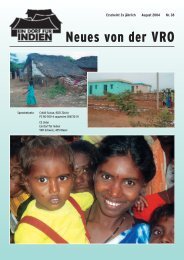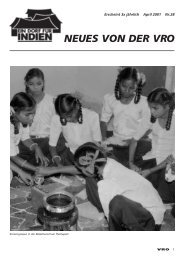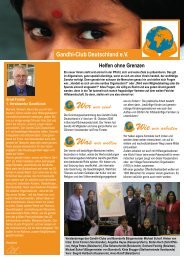+ + Annual Report [2012 â 2013]
+ + Annual Report [2012 â 2013]
+ + Annual Report [2012 â 2013]
You also want an ePaper? Increase the reach of your titles
YUMPU automatically turns print PDFs into web optimized ePapers that Google loves.
+<br />
Employment (Work)<br />
The work participation ratio as per the 2001 census reveals that 39.1% of total population belong to <br />
working class: out of which the marginal workers consist of a large rural population that is 8.7%.This <br />
indicates that the working population of the country is less with a greater percentage of unemployment. <br />
The two major reasons for unemployment are lack of opportunities and lack of required skills to be <br />
employed. Addressing the need for employment, VRO initiated two major programs i.e. Livelihood Learning <br />
Program and Village Development Training Program. <br />
These programs targeted the youth (boys and girls) and adult women. These programs brought about <br />
change in the attitude of the target population and helped in building their skills which in turn enhanced <br />
their ability to set-‐up a small scale business on their own or utilize the employment opportunities that are <br />
available in the locality. The core objective of the program is to build a rural community that can enhance <br />
their economic status through creating self-‐employment opportunities. This year the programs addressing <br />
the need of employment have shown a greater impact especially among the rural women (both young girls <br />
and adult women).<br />
Programs addressing Objective of ‘Employment (Work)’<br />
+<br />
LIVELIHOOD LEARNING CENTER (LLC) <br />
VILLAGE DEVELOPMENT TRAINING CENTER (VDTC) <br />
A Livelihood Learning Center is a place where the <br />
youth are trained on skills such as electrical (House <br />
wiring, fan winding etc.) along with basics in <br />
carpentry. They are also given training on other <br />
skills like leadership, games and sports etc. The <br />
program is structured to impart the core objectives <br />
of VRO i.e. the 4Es (Environment, Enlightenment, <br />
Employment and Enjoyment) of the Founder <br />
Director of VRO, Fr. M. A. Windey sj. The trainees <br />
will be taught about each ‘E’ through their daily <br />
routine that includes fieldwork and cleaning the <br />
surroundings (Environment), learning, awareness <br />
building on their responsibility and rights, value <br />
classes (Enlightenment), skill training like electrical, <br />
carpentry (Employment) and cultural activities like <br />
music, singing, dance (Enjoyment) etc. The trainees <br />
who are interested in completing their academic <br />
course are enabled to do so. The LLC have both the <br />
residential and non-‐residential centers. <br />
The Livelihood Learning Centers were able to train <br />
243 trainees at 10 service centers in A. P and <br />
Odisha states.<br />
As the CCCP acts as the entry point, the VDTC acts <br />
as the exit strategy in the cycle of creating citizens <br />
to take care of their own villages. The village youth <br />
are targeted under this program. The VDTC imparts <br />
training on computers (Boys), tailoring, handicraft <br />
and Multi-‐Purpose Health Worker (MPHW) course <br />
(Girls). The major difference between LLC and VDTC <br />
is the following: the trainees will be oriented both <br />
theoretically and practically on creating <br />
employment opportunities in the village. This is a <br />
residential program along with village level service <br />
camps during the training. <br />
The Village Development Training Centers were <br />
able to train 112 trainees at 5 service centers in <br />
the three operational states <br />
11


![+ + Annual Report [2012 â 2013]](https://img.yumpu.com/37081838/11/500x640/-annual-report-2012-a-2013.jpg)









